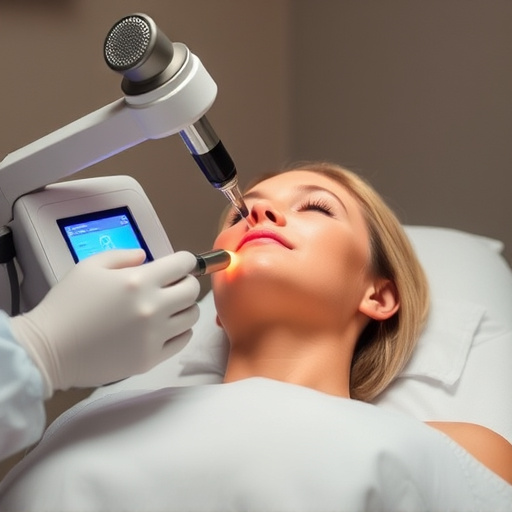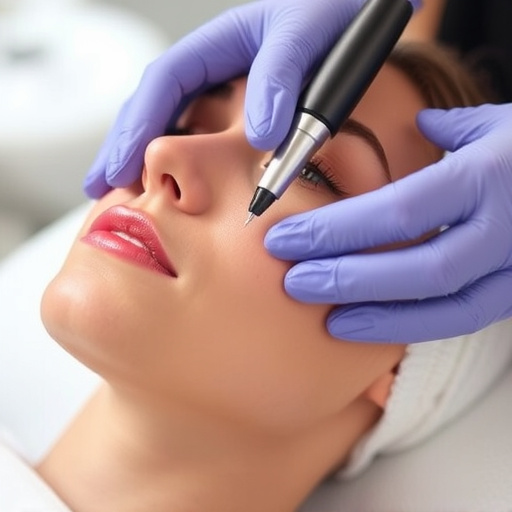Spider Vein Treatment: Comprehensive Before-and-After Care Guide
Spider veins, caused by various factors like age, genetics, or prolonged standing, weaken vein valve…….
In the realm of dermatology and vascular health, spider vein treatment has emerged as a critical aspect of addressing aesthetic concerns and improving overall well-being. This comprehensive article aims to delve into the intricate world of spider vein management, exploring various facets that impact its practice and potential. From understanding the condition itself to examining global trends and technological innovations, readers will gain valuable insights into how spider vein treatment is shaping up in today’s medical landscape.
Definition: Spider veins, also known as telangiectasias, are small, abnormally dilated blood vessels that appear close to the skin’s surface. They often resemble a spider web or a network of tiny, red, blue, or purple lines, hence the name. Spider vein treatment involves various medical and cosmetic procedures designed to reduce their visibility or eliminate them altogether.
Core Components: The primary goal of spider vein treatment is to restore normal blood flow and minimize the appearance of these dilated vessels. Common treatment modalities include:
Historical Context: The management of spider veins has evolved significantly over the years. Ancient civilizations like the Greeks and Romans recognized the condition, but treatment options were limited to herbal remedies and compression bandages. Modern advancements began in the 20th century with the introduction of sclerosant solutions, followed by laser technology in the late 1980s. Today, a multitude of treatments are available, offering patients more choices and improved outcomes.
Spider vein treatment has garnered worldwide attention, with varying levels of adoption and popularity across regions. Here’s an overview:
| Region | Trends and Adoption | Influencing Factors |
|---|---|---|
| North America | High adoption rate; considered a common cosmetic procedure. Laser and sclerotherapy are the most popular methods. | Advanced medical infrastructure, high disposable income, and a culture of aesthetic enhancement. |
| Europe | Widespread availability of treatments, with laser therapy leading the way. Strict regulatory standards ensure patient safety. | Strong emphasis on healthcare accessibility, diverse cultural preferences, and stringent cosmetic regulations. |
| Asia-Pacific | Growing market, particularly in Japan and South Korea, with a focus on minimally invasive procedures. | Increasing disposable income, rising demand for cosmetic treatments, and innovative technology adoption. |
| Latin America | Rising trend, especially among urban populations. Sclerotherapy is commonly used, and prices are often more affordable. | Economic disparities, growing middle class, and a blend of traditional and modern medical practices. |
| Middle East & Africa | Varied adoption rates; some countries have advanced cosmetic medicine, while others focus on basic healthcare. | Limited access to quality healthcare, cultural attitudes towards appearance, and economic development levels. |
These regional variations highlight the multifaceted nature of spider vein treatment’s global impact. As medical technology advances and economic conditions change, the landscape is constantly evolving.
The economic aspects of spider vein treatment are significant, impacting both patients and healthcare systems.
Technological innovations have played a pivotal role in enhancing spider vein treatment options and improving patient outcomes.
Regulatory frameworks play a crucial role in ensuring patient safety and quality care in spider vein treatment.
Despite its advancements, spider vein treatment faces several challenges and criticisms that require addressing for optimal patient outcomes.
Common Issues:
Strategic Solutions:
Patient Profile: A 42-year-old female with a long history of spider veins on her legs, particularly prominent after pregnancy. Conventional sclerotherapy treatments had provided temporary relief but left visible scars.
Treatment Approach: A multidisciplinary team employed a combination of laser and RF ablation techniques. High-resolution ultrasound guided the precise application of lasers, targeting deeper veins while minimizing damage to surrounding skin.
Outcomes: After a series of sessions, the patient experienced significant improvement in vein appearance and discomfort. Ultrasound images confirmed successful closure of target vessels with minimal side effects. The patient’s satisfaction was high, citing improved self-confidence and mobility.
Patient Profile: A 35-year-old male seeking a non-invasive solution for small, unsightly spider veins on his face, specifically around the nose and cheeks.
Procedure: The patient underwent microliposis, a minimally invasive surgical procedure. Tiny incisions were made, and the affected spider veins were carefully removed using specialized tools.
Results: Post-operative care included compression and mild pain management. Within two weeks, the patient noticed a dramatic improvement in vein appearance, achieving his desired aesthetic outcome. Follow-up sessions ensured any remaining veins were addressed, providing long-lasting results.
The future of spider vein treatment holds immense potential for improved patient care and enhanced outcomes.
Spider vein treatment represents a complex yet fascinating area within dermatology and vascular medicine. As technology advances, regulatory frameworks evolve, and healthcare systems adapt, the field is poised for significant growth and positive impact. By addressing global trends, economic considerations, and technological breakthroughs, we can ensure that spider vein treatments are accessible, safe, and effective for individuals seeking relief from these unsightly conditions.
Q: Is spider vein treatment painful?
A: Discomfort levels vary, but modern techniques like laser and RF ablation use advanced anesthesia methods to minimize pain during and after the procedure.
Q: How many treatments are typically needed?
A: The number of sessions depends on the severity and size of the veins. Smaller spider veins may require one treatment, while larger areas might need 3-6 sessions spaced weeks apart.
Q: Are there any long-term effects or risks associated with these treatments?
A: When performed by qualified professionals, spider vein treatments are generally safe. However, as with any medical procedure, there are potential risks, including skin discoloration, bleeding, and infection. Long-term results vary, and regular maintenance may be needed to sustain improvements.
Q: Can spider vein treatment improve blood circulation?
A: While the primary focus is on cosmetic improvement, some procedures like sclerotherapy have been shown to temporarily enhance blood flow in treated areas by sealing off abnormal veins.
Q: Is insurance coverage available for these treatments?
A: Coverage varies widely. Some insurance plans may cover certain procedures under specific circumstances, such as for medical reasons or severe aesthetic concerns. It’s essential to check with individual providers and insurers.

Spider veins, caused by various factors like age, genetics, or prolonged standing, weaken vein valve…….

Spider veins, influenced by various factors like genetics and lifestyle, cause cosmetic and comfort…….

Spider vein treatment utilizes non-invasive techniques like laser therapy, radiofrequency ablation,…….